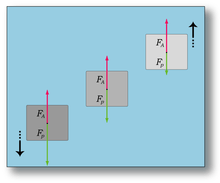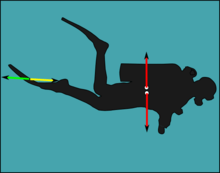Neutral buoyancy
Neutral buoyancy is a condition in which a physical body's average density is equal to the density of the fluid in which it is immersed. The buoyancy offsets the force of gravity that would otherwise cause the object to sink (if the body's density is greater than the density of the fluid in which it is immersed) or rise (if it's less). An object that has neutral buoyancy will neither sink nor rise.


In scuba diving, the ability to maintain neutral buoyancy through controlled breathing, accurate weighting, and management of the buoyancy compensator is an important skill. A scuba diver maintains neutral buoyancy by continuous correction, usually by controlled breathing, as neutral buoyancy is an unstable condition for a compressible object in a liquid.
History
The mathematician Archimedes discovered much of how buoyancy works more than 2000 years ago. In his research, Archimedes discovered that an object is buoyed up by a force equal to the weight of the water displaced by the object. In other words, an inflatable boat that displaces 100 pounds (45 kilograms) of water is buoyed up by that same weight of support. An object that floats in the water is known as being positively buoyant. An object that sinks to the bottom is negatively buoyant, while an object that hovers at the same level in the water is neutrally buoyant. Scientists later discovered ways to manipulate buoyancy and developed equipment such as the life jacket, which is filled with compressed air and helps to lower a person's average density, assisting in floating and swimming, as well as certain diving equipment (including submarines and submersibles) which have air chambers similar to swim bladders to regulate depth.
Uses
Buoyancy is important in a large number of fields. Boats, ships and seaplanes are engineered in a way that ensures that they remain afloat. Submarines have controllable buoyancy to make them submerse and rise on demand. Many objects were developed with buoyancy in mind, such as life preservers and pontoons.
Buoyancy is essential to most water sports. Many swimmers know that there are easy ways to float at the surface, such as lying on one's back or holding a full breath. Buoyancy becomes noticeable when a swimmer tries to dive to the bottom of the pool, which can take effort. Scuba divers work with many buoyancy issues, as divers must know how to float, hover and sink in the water. Scuba divers often wear lead weights to counteract the positive buoyancy of their bodies and gear.
Microgravity simulation
Neutral buoyancy is used extensively in training astronauts in preparation for working in the microgravity environment of space. NASA and the Russian space program maintain facilities in which suited astronaut trainees interact with mock-up space hardware, with the assistance of scuba divers. At the University of Maryland's Space Systems Laboratory, a neutral buoyancy tank is similarly used to evaluate the performance of prototype space robots.
Characteristics
When neutral buoyancy is taking place, it appears as though the object/substance is floating in the middle of the fluid, or somewhere in between the bottom and the surface.
Appearance in nature
A fish's swim bladder manipulates neutral buoyancy by controlling the amount of air in the swim bladder, allowing it to swim at different depths. In effect a fish's density becomes higher or lower than the surrounding water due to the varied counter-action of the density of air in its bladder.
The human brain exhibits neutral buoyancy as a result of its suspension in cerebrospinal fluid. The actual mass of the human brain is about 1400 grams; however the net weight of the brain suspended in the CSF is equivalent to a mass of 25 grams. The brain therefore exists in neutral buoyancy, which allows the brain to maintain its density without being impaired by its own weight, which would cut off blood supply and kill neurons in the lower sections.
Demonstrating neutral buoyancy
Demonstrating neutral buoyancy can be simple. Find a non-absorbent and incompressible object, and two miscible fluids, one that is more dense than the object and one that is less dense. In the first fluid, the object will float. In the second, it will sink. However, when the two liquids are mixed, it will be somewhere in between, and when the density of the fluid equals the average density of the object it will have neutral buoyancy and remain at any given depth unless disturbed.
Density of everyday substances (in g/cm3)
| Water | Ice | Vinegar | Salt Water | Milk(Skim) |
|---|---|---|---|---|
| 1.00 | 0.92 | 1.01[1] | 1.03 | 1.033 |
References
See also
- Buoyancy
- Category:Neutral buoyancy facilities
- Neutral buoyancy simulation as a training aid

